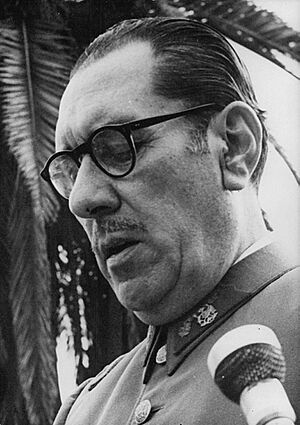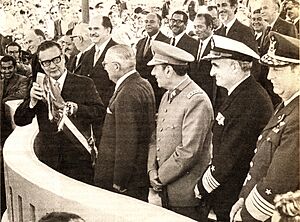Carlos Prats facts for kids
Quick facts for kids
Carlos Prats
|
|
|---|---|
 |
|
| Commander-in-chief of the Chilean Army | |
| In office October 27, 1970 – August 23, 1973 |
|
| President | Salvador Allende |
| Preceded by | René Schneider |
| Succeeded by | Augusto Pinochet |
| Chilean Minister of the Interior | |
| In office November 2, 1972 – March 27, 1973 |
|
| President | Salvador Allende |
| Preceded by | Jaime Suárez |
| Succeeded by | Gerardo Espinoza Carrillo |
| Chilean Minister of National Defense | |
| In office August 9, 1973 – August 23, 1973 |
|
| President | Salvador Allende |
| Preceded by | Clodomiro Almeyda |
| Succeeded by | Orlando Letelier |
| Personal details | |
| Born | February 24, 1915 Talcahuano, Chile |
| Died | September 30, 1974 (aged 59) Buenos Aires, Argentina |
| Cause of death | Assassination (car bomb) |
| Political party | Independent |
| Spouse |
Sofía Cuthbert
(m. 1944–1974) |
| Children | 3 |
| Profession | Military officer |
| Signature | |
Carlos Prats González (born February 24, 1915 – died September 30, 1974) was an important Chilean Army officer and politician. He served as a top minister in Salvador Allende's government. At the same time, he was the Commander-in-chief of the Chilean Army. After a military takeover led by General Augusto Pinochet in September 1973, Prats left Chile and went to live in Argentina. The next year, he and his wife, Sofía Cuthbert, were killed in Buenos Aires by a car bomb. This attack was carried out by a secret police group called the Dirección de Inteligencia Nacional.
Contents
Early Life and Military Career
Carlos Prats González was born in Talcahuano, Chile, in 1915. He was the oldest son of Carlos Prats Risopatrón and Hilda González Suárez. Carlos joined the Army in 1931 and was a very good student, graduating at the top of his class.
In 1935, he became an officer in the artillery, which handles large guns. Three years later, he became a Sub-lieutenant. He soon returned to the Military Academy, but this time as a teacher. He taught there and at the War Academy until 1954. In 1944, he married Sofia Cuthbert Chiarleoni. They had three daughters together.
In 1954, Prats González was promoted to Major. He was sent to the United States to work with the military there until 1958. That year, he became a Lieutenant Colonel and went back to the War Academy to teach again. In the early 1960s, he led different artillery regiments.
In 1964, Prats González became a Colonel and was sent to Argentina as a military representative. He returned to Chile in 1967 to lead the III Army Division. In 1968, he was promoted to Brigade General and became the Chief of the General Staff, a very important leadership role. The next year, he became a Division General.
Role During Allende's Presidency

When Salvador Allende was elected president in 1970, General Prats became a key figure. He led a group in the armed forces who believed in following the country's laws and constitution. This idea was known as the Schneider Doctrine. Over time, General Prats became one of President Allende's strongest supporters in the army. He was asked many times to be part of Allende's government. In 1972, Allende even named him Vice-President. In Chile, the Minister of the Interior temporarily acts as "vice president" when the President is away.
General Prats' reputation faced a challenge in June 1973 during an event known as the Alejandrina Cox incident. He was involved in an argument with some people and fired a shot at their car. He offered to resign right away, but President Allende did not accept it. A few days later, there was an attempted military takeover called the Tanquetazo. General Prats acted quickly to stop it, which helped improve his public image.
Resignation from the Army
On August 22, 1973, the wives of other generals and officers held a protest outside Prats' home. They called him a coward for not bringing order back to Chile. This event made Prats realize that he had lost the support of his fellow officers. The very next day, he resigned from his roles as Interior Minister and as Commander-in-Chief of the Army. Two other generals who also supported the constitution, Generals Mario Sepulveda Squella and Guillermo Pickering, also resigned to show their support for Prats.
General Augusto Pinochet, who was second in command and seemed loyal to Allende, was then appointed Commander-in-Chief of the Army. Prats himself had suggested to Allende that Pinochet should get the job.
Prats' retirement removed a major obstacle to a military takeover. Three weeks later, on September 11, 1973, the military coup happened. Soon after the coup, on September 15, 1973, Prats and his wife decided to leave Chile and live in Argentina.
Death
On September 30, 1974, in Buenos Aires, Argentina, Carlos Prats and his wife Sofia were killed. A bomb placed in their car exploded outside their apartment. The explosion was so powerful that pieces of the car reached the ninth floor of a building across the street.
Investigations and Justice
Years later, in 1983, a man named Michael Townley admitted that he helped carry out the assassination of Prats. He said he did it for officials from the DINA, which was Chile's secret police.
In 2003, former leaders of DINA, including its chief Manuel Contreras, were charged in Chile with Prats' assassination. They were later found guilty. In Argentina, another DINA agent, Enrique Arancibia, was found guilty in 2004 and sentenced to life in prison for Prats' murder. Investigations continued in both countries to find all those responsible for the attack.
See also
 In Spanish: Carlos Prats para niños
In Spanish: Carlos Prats para niños
- Chile under Allende

